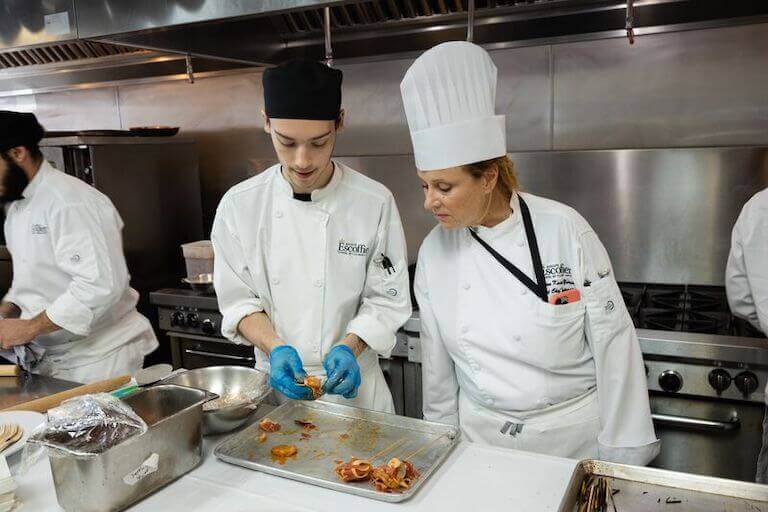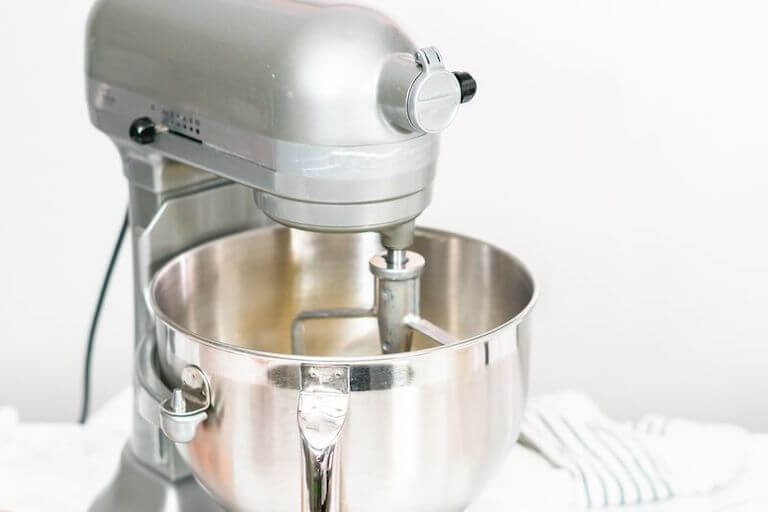Want to know the secret ingredient to every successful food blog? Passion. If you’ve got that, it’s time to roll up your sleeves, tie on your favorite apron, and get cooking (or typing).
But before you share your favorite recipes, you have some decisions to make. What do you want your blog to accomplish? What will set it apart? And how do you go about creating a website from scratch?
As with anything worth doing, creating a food blog can take hard work and dedication. Ready to jump in? Here’s a step-by-step guide for how to start a food blog.
Build Your Skills and Lock In Your Purpose
1. Refine Your Skills So You Can Demonstrate Authority
If you’re going to create a great food blog, you may want to show people why you’re qualified to teach them about food. As one of the most reputable food blogs in the country, America’s Test Kitchen is a great example of a blog with authority. Founded in 1993, ATK has established itself as a trusted cooking source over the years through television, radio, blogging, and cookbooks. The brand upholds rigorous standards of quality in recipe development by hiring accomplished chefs and writers and staying on top of trends in cooking.
ATK has earned a reputation for being reliable and innovative. A reputation like this doesn’t happen overnight, but investing in earning your readers’ respect and trust is more than worth it.
What if you don’t have a decades-long resume? Another option is to pursue a culinary school credential. At Auguste Escoffier School of Culinary Arts, students may earn a culinary degree or diploma, helping to demonstrate that the graduate has invested time and hard work into their craft.

Attending culinary school may help to validate your advice and instruction.
As a food blogger, confidence is key. If you show confidence from the start, and you support it with expertise, your readers may be more likely to take you seriously and respect what you’re doing.
“[Escoffier] sparked two exciting new adventures for me: building my own allergy-friendly cookie business, Gaia Cookies, and starting a food blog for fun on the side, Cook ‘n’ Kickass – Food, Wellness, How-Tos & More.”*
Heather Arcay, Escoffier Culinary Arts Graduate & Food Blogger, Cook ‘n’ Kickass
2. Approach Your Blog as a Business
Some food writers simply blog for fun. But if you want your blog to be a money-making venture (more on that later), then you’ll most likely want to approach your blog as a business. That means that not only are you a food blogger…you’re a food entrepreneur.
Small business owners have to devote plenty of time to their work. And they have to work hard to get their content in front of as many people as they can, as blog traffic is often directly related to income.
To truly understand the ins and outs of running your own business, you can’t beat education. Escoffier’s Food Entrepreneurship programs include coursework in food styling, food photography, social media development, food blogging, recipe development, and much more. With this background, students and graduates may find the path to a thriving blog is an easier one to tread!
“Entrepreneurship is the way forward.”*
Chef Michelle Blaine, Escoffier Online Culinary Arts Graduate
3. Find Your Niche
The internet is saturated with food blogs, but that shouldn’t discourage you from starting one. You just have to commit to setting yours apart from the rest. A good way to do this is to focus on a single corner of the culinary world.
Look at it this way: a vegan baker is more likely to seek out vegan baking blogs where they know they’ll find recipes tailored just to them, rather than a general baking blog where every recipe includes eggs or butter and must be customized.
Some examples of food blog niches include:
- Healthy recipes
- Plant-based recipes
- Recipes from specific cultures or countries
- Cooking for children
- Cooking for specific diets
- 30-minute meals
- Restaurant reviews (not cooking at all!)
- Cooking on a budget
- Baking blogs
- Recipes for one
- Recipes for large families
You may choose to do a little bit of everything in your blog but you should lean into the one thing that you’re best at or most passionate about, whether that’s a type of cuisine or a cooking style. This will make it easier to maintain your blog and target readers interested in your brand.

A blog dedicated to gluten-free baking may be able to connect with a target audience more strongly than a general baking blog.
4. Identify Your Audience
Closely related to choosing your niche is identifying your audience. For whom are you creating this content? A blog about cooking for children, for example, would have an audience of parents. What’s important to many parents? It could be healthy meals that are affordable and can be made quickly. With this in mind, you can tailor both your recipes and your language to that group. There are also stay-at-home parents who have the time and inclination to make more complex meals. This is a different audience, even though the basic niche is the same.
For a great example of a food blog with a specific audience, look to Serious Eats. This popular food blog is for the home chef who is serious about cooking. Not quite beginners but not quite experts, this blog’s audience is composed of intermediate-level food enthusiasts that want to challenge themselves.
So how do you decide who you want your audience to be? If you’re newer to cooking or have not trained professionally, you may want to cater to home chefs who are still learning the basics. If you’re a practiced chef with certifications to prove it, you may choose to focus on helping readers understand what makes techniques effective and flavors complimentary.
There is no correct answer for who your audience should be, but you should be thinking about them now. As your blog grows, you will have a clearer idea of what type of reader you want to focus on.

Who do you think will be reading your blog?
5. Decide What You Hope to Accomplish
Another important step when starting a food blog is to decide how it will fit into your long-term career goals.
Some cooks and chefs choose to start food blogs to support other businesses. Plant-based personal chef and Escoffier graduate Shane Witters Hicks, for example, has a food blog on his website to help support his personal chef services and cooking classes.*
Others choose to create blogs with the hopes of using them as a source of income on their own, either to supplement their other work or to replace it entirely!
Whatever you choose to work toward with your blog, commit to it. Your goals may change over time, but your blog should never be without a purpose.

A blog could support another business, like your cooking classes.
Create Your Brand and Your Website
6. Choose a Name For Your Blog
Once you have the big picture established, it’s time to get into the details. First, you’ll need to name your blog. Your blog should have a name that’s catchy and short so it’s easy to remember.
It may also be a good idea for the name to reflect your niche. For example, well known vegan blog The Edgy Veg tells you a lot in just three words: it’s vegetarian, and it’s got a bit of an attitude!
Once you have a name in mind, do a Google search to make sure the name and URL aren’t already in use. You should also do a name search with your state to make sure your blog name isn’t already in use with another business. And you may want to do a federal trademark search as well. Skipping this step could get you into legal trouble down the road. If you do find a business or blog with a similar name, consult an attorney before moving forward!

Do a name search online and with your state to make sure your dream blog name isn’t already taken or registered to another business.
7. Choose a Blogging Platform
Your blogging platform is the service you’ll use to actually build and design your website. There are many options out there, including WordPress, Squarespace, Wix, and more.
Each has its own benefits. WordPress, for example, was originally designed for blogs and has lots of templates to start with, plus thousands of plugins for customizing your site. Squarespace has an intuitive drag-and-drop builder that makes it easy to create a beautiful site. And Wix lets users create basic websites for free.
Do a thorough comparison of the different platforms before you get started, as migrating your site from one to another after you’ve launched can be a complicated process.
8. Choose a Web Host
The visual elements of your site will be built on your blogging platform. But behind the scenes, your site’s code has to “live” somewhere on the internet where it can be accessed by users. That home is provided by a web host. Your site will live on the web host’s servers, and you’ll pay a subscription fee to “rent” server space.
Some popular web hosting providers include Bluehost, HostGator, and SiteGround. Most web hosting providers also give you the opportunity to create the domain name for your blog. A domain name is your primary web address, like www.escoffier.edu. You will have to purchase your domain name and renew it periodically.
9. Design Your Blog Website
Once you have your blogging platform and web host set up, you can start designing your site! You will have the option to design your site from scratch, but it’s much easier to start with a template.
Choose a design template that is visually appealing and easy to navigate, with a simple menu. Make sure to keep mobile users in mind as you create your site! As of February 2023, just over 60% of internet traffic came from a mobile device. Mobile traffic could be even higher for food blogs, as it’s common for people to follow along with a recipe from their phones in their home kitchens. So you should really think of smartphones first when designing your blog!
Mobile-friendly design includes features like:
- A “responsive” layout that automatically reorients itself to fit computer screens, tablets, or mobile devices. Most layouts these days are automatically responsive.
- Keeping pop-ups to a minimum, as they can take up the entire phone screen.
- Ensuring elements like buttons and fonts are large enough to read and interact with on a phone screen.

Make sure your blog is easy to navigate on a computer and a smartphone.
Start Blogging and Sharing Your Content
10. Write Your First Blog Post
Time to create your content!
A successful blog is engaging, informative, and useful to your target audience. It includes high-quality photos of your food, accurate ingredients, and step-by-step instructions for your recipes. You may also choose to create process videos so your visitors can follow along with you!
Many food bloggers choose to include anecdotes or stories along with their recipes. This can help to draw in your readers and create a stronger connection with them. But it’s a good idea to also have a “Jump to Recipe” button for those who just want to get to the instructions.
According to Escoffier graduate and food blogger Sarah Schweitzer, “Great innovative food photos are very important in blogging…The lighting, camera angles, and the way that you plate introduce the recipes and showcase the food you are presenting. Food photos are like a fashion model’s photos. You’re preparing your foods for the ‘food runway.’”*
Sarah also recommends keeping your recipe instructions simple. “If somebody looks at your recipe and if it’s too big or too lengthy, they’re probably not going to try it out. So, try to simplify all of your recipes, making them user-friendly,” she says.*
How often you post is up to you, but it’s important to be consistent. A new recipe every week or so will help keep your blog content fresh and keep your readers coming back to see what’s new. If you can post more, that’s great!

Video content can supplement your written blog and help users to visualize the steps.
11. Promote Your Blog
Actively promoting your blog can help you to grow your traffic. You can promote your blog on social media platforms like Facebook, Twitter, Instagram, Pinterest, and TikTok. You may also wish to create an email list. People who like your content can opt-in to your emails so you can let them know every time you have a new blog post up. This lets you reach out directly to your audience without relying on fickle social media algorithms.
You can also join food blogging communities and forums to connect with other bloggers and share your content. And you can collaborate with other bloggers to leverage each other’s audiences.
Getting more eyes on your content is crucial, so don’t skip this step!
“Simply enjoy the experience of food in your life and be willing to share recipes and tips with others.”*
Sarah Schweitzer, Escoffier Online Baking & Pastry Graduate and Food Blogger
12. Monetize Your Blog (If You Choose!)
Once you have built a following, you may choose to monetize your blog.
There are many ways that food writing can earn income. You may choose to work with Google AdSense or another ad platform that will display ads on your site and pay you based on the number of views your site generates.
You can also create sponsored content, working with outside companies to promote their products. For this type of monetization, you may create a recipe using a certain ingredient or kind of cookware. Sponsored posts are often paid a flat rate by the outside brand.
Another option is affiliate marketing. This is when a blogger includes links to certain products in their blog. When a reader clicks the link and goes on to make a purchase, the blogger can earn a commission on that sale.
Then there’s the option to create your own products. Bloggers have gone on to create and sell cookbooks, mugs and t-shirts, meal planners, spice blends, and more. Get creative!

Sharing links to products you use, like a stand mixer, may let you earn affiliate income on each sale.
Ready to Get Started?
It’s time to take the next steps to get your food blog off the ground. You could start by perfecting your best recipes, researching food blogs you admire, or reaching out to friends and family for feedback on your food.
Or maybe the next step is to get that diploma or degree you’ve always wanted. Whether you choose to pursue an education in culinary arts to improve your cooking or study food entrepreneurship for a more business-minded approach, education may help you feel more confident in your abilities and build your qualifications.
To learn more about culinary education at Auguste Escoffier School of Culinary Arts, contact us today!
For more ways to share your passion for cooking with the world, check out these articles:
- How To Become a Foodie Influencer
- How to Start a Food Business From Home
- Building an Online Pastry Shop
This article was originally published on February 20, 2017, and has since been updated.
*Information may not reflect every student’s experience. Results and outcomes may be based on several factors, such as geographical region or previous experience.

 “Simply enjoy the experience of food in your life and be willing to share recipes and tips with others.”*
“Simply enjoy the experience of food in your life and be willing to share recipes and tips with others.”*

